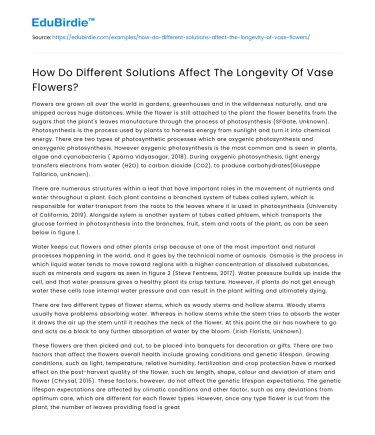Flowers are grown all over the world in gardens, greenhouses and in the wilderness naturally, and are shipped across huge distances. While the flower is still attached to the plant the flower benefits from the sugars that the plant's leaves manufacture through the process of photosynthesis (SFGate, Unknown). Photosynthesis is the process used by plants to harness energy from sunlight and turn it into chemical energy. There are two types of photosynthetic processes which are oxygenic photosynthesis and anoxygenic photosynthesis. However oxygenic photosynthesis is the most common and is seen in plants, algae and cyanobacteria ( Aparna Vidyasagar, 2018). During oxygenic photosynthesis, light energy transfers electrons from water (H2O) to carbon dioxide (CO2), to produce carbohydrates(Giuseppe Tallarico, unknown).
There are numerous structures within a leaf that have important roles in the movement of nutrients and water throughout a plant. Each plant contains a branched system of tubes called xylem, which is responsible for water transport from the roots to the leaves where it is used in photosynthesis (University of California, 2019). Alongside xylem is another system of tubes called phloem, which transports the glucose formed in photosynthesis into the branches, fruit, stem and roots of the plant, as can be seen below in figure 1.
Water keeps cut flowers and other plants crisp because of one of the most important and natural processes happening in the world, and it goes by the technical name of osmosis. Osmosis is the process in which liquid water tends to move toward regions with a higher concentration of dissolved substances, such as minerals and sugars as seen in figure 2 (Steve Fentress, 2017). Water pressure builds up inside the cell, and that water pressure gives a healthy plant its crisp texture. However, if plants do not get enough water these cells lose internal water pressure and can result in the plant wilting and ultimately dying.
There are two different types of flower stems, which as woody stems and hollow stems. Woody stems usually have problems absorbing water. Whereas in hollow stems while the stem tries to absorb the water it draws the air up the stem until it reaches the neck of the flower. At this point the air has nowhere to go and acts as a block to any further absorption of water by the bloom. (Irish Florists, Unknown).
These flowers are then picked and cut, to be placed into banquets for decoration or gifts. There are two factors that affect the flowers overall health include growing conditions and genetic lifespan. Growing conditions, such as light, temperature, relative humidity, fertilization and crop protection have a marked effect on the post-harvest quality of the flower, such as length, shape, colour and deviation of stem and flower (Chrysal, 2015). These factors, however, do not affect the genetic lifespan expectations. The genetic lifespan expectations are affected by climatic conditions and other factor, such as any deviations from optimum care, which are different for each flower types. However, once any type flower is cut from the plant, the number of leaves providing food is greatly limited, as is the amount of light available for food production, and therefore as a result the amount of food available to the flower is drastically reduced.
Temperature and humidity are particular factors that can determine whether the cut flower will be delivered to the consumer in good condition after the harvest (Lynn Byczynski, unknown). Higher temperatures promote flower development, while humidity plays an indirect role in the condensation process during temperature fluctuations and promotes the growth of bacteria. Lack of hygiene promotes the development of micro-organisms, which can cause water to become turbid and smelly (Lynn Byczynski, unknown).
Some solution other than water that have been known to work for increasing the longevity of flower vase life are lemon juice, bleach, sugar water, and flower food. Lemon juice has been known to help extend the longevity of vase life, however this ideal is exemplified on how it is used. Adding to much lemon juice onto a plant can cause it to shrivel and compromise its ability to perform photosynthesis. This is because adding small amounts of lemon juice to the soil makes the soil more acidic, altering the pH, but pouring it over the plant's leaves can burn them and kill the plant (SFGate, unknown). Bleach has been known to be beneficial for killing bacteria that is nestled in the flower stems, the vase or the water (Donna Thacker, unknown). Through killing the bacteria, it is unable to travel through the flowers stem and make the plant ‘sick’, preventing it from wilting and dying rather quickly. Bleach is a poison, and if it overused it will quickly kill your flowers, where as if it is used correctly it will cause little harm potentially causing the flower to fade a little in colour. Another solution that is commonly suggested in sugar water. Before being cut the flower benefits from the sugars that the plant's leaves manufacture through the process of photosynthesis, however once the flower is cut from the plant, the number of leaves providing food is greatly limited, as is the amount of light available for food production (SFGate, unknown). As a result, the amount of food available to the flower is drastically reduced. To make up for this loss, sucrose is added to the water the flower stems are placed into to ensure the continued development of the flower and greater longevity (Sugar water? When cut flowers are bought from the shops or florists, they usually are given with a small packet of flower food. Flower food has a combination of ingredients which include citric acid, sugar and a small amount of bleach that are to be added to the vase filled with water. These ingredient vary depending on what brand and type of flowers that are bought.






 Stuck on your essay?
Stuck on your essay?

